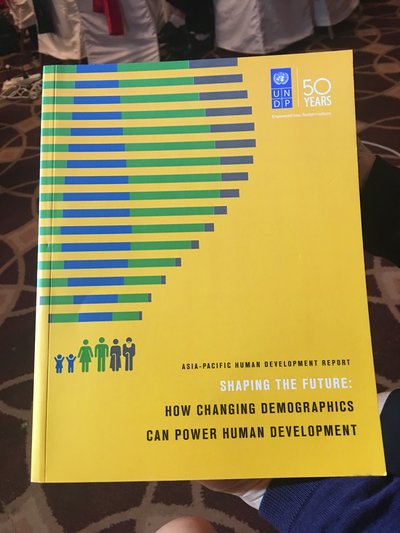BEIJING, April 26, 2016 /PRNewswire/ -- Demographic change in Asia and the Pacific is happening at a rate the world has never seen. An explosion in the working age population and a fall in birth rates that took a century in Europe are happening here in just 30 years.

If countries do not start planning for this demographic change, they will miss out on a unique opportunity to boost growth and investments for the future, says the United Nations Development Programme (UNDP) in its latest Regional Human Development Report. They also risk a surge in youth frustration, exacerbating instability and conflict.
The report, entitled "Shaping the Future: How Changing Demographics Can Power Human Development," notes that Asia-Pacific countries now have more working-aged people and fewer dependents than at any point in history, providing a springboard for growth. Region-wide, 68 percent of people are of working age and only 32 percent are dependents.
"When countries have a greater share of people who can work, save and pay taxes, they have the potential to transform their economies and power investments in healthcare, education and other building blocks of future prosperity," said Thangavel Palanivel, lead author of the report.
The report calls for immediate responses and outlines "9 Actions for Sustainable Development." These are concrete policies tailored to the demographic profile of individual countries.
For states with a large working-aged population, UNDP is calling for the creation of decent jobs to match the growing workforce, equal employment for women, and ways to turn savings into investments inside the region.
For countries with young populations, there is a need to invest in education and healthcare, smooth the transition from school to work and encourage youth participation in public life.
In older countries, governments have to design fair, sustainable pension systems, support active ageing and promote appreciation for the value of older citizens. This includes making sure that older people who want to work can bring their skills and experience to the market.
"The window of opportunity to increase productivity, invest in growth and save for the future is between now and 2050," said Haoliang Xu, UN Assistant Secretary-General and UNDP Director for Asia and the Pacific. "If countries in Asia-Pacific do not create optimal employment conditions, the regional economy will begin to slow down by 2050 as the current working-aged population begins to retire."
With 58 percent of all the working people on earth, what happens in Asia-Pacific will affect countries far beyond the region.
"Growth, employment and migration in the west are inextricably linked to what happens in the east," said Haoliang Xu. "The sun rises here, but its effects are soon felt on the other side of the world."
There is no one solution for every country, but the region's diversity provides room for south-south cooperation. Governments need to share experiences on long-term fiscal planning, including the sustainable use of tax revenue. Cooperation can also encourage safe migration from younger to older countries within the region and reduce the desperate flight of migrants to Europe.
"With 50 years of expertise and offices in 24 countries in Asia-Pacific, UNDP is ideally placed to help implement the '9 Actions for Sustainable Development'," said Haoliang Xu. "We can facilitate partnerships combining domestic, international, public and private funding and expertise on youth, ageing, migration, social protection, climate change and disaster risk management, governance, urbanization and technology transfer."
Related Links
Microsite: www.asia-pacific.undp.org/hdr
Overview: bit.ly/RHDRSummary
Full Report: on.undp.org/dF8
Hashtag: #RHDR2016
To download the report, please click here.